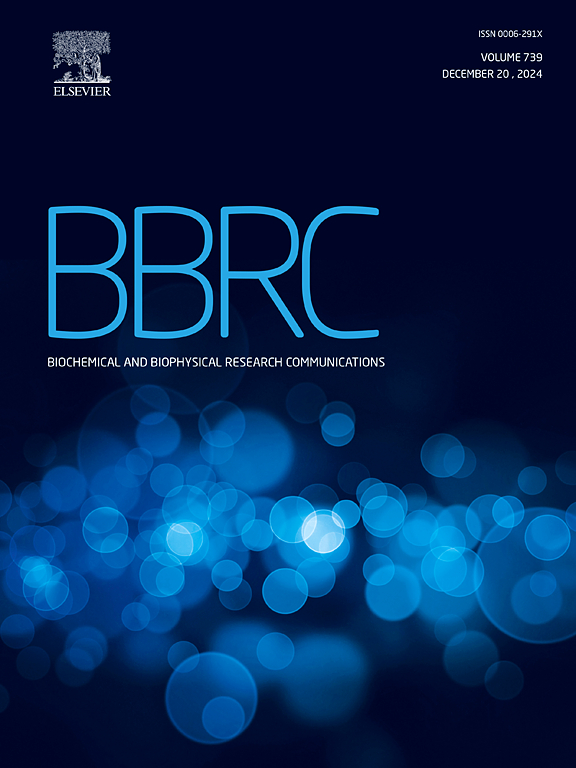Long noncoding RNA IDI2-AS1 modulates the expression of interleukin 5 in human cells
IF 2.5
3区 生物学
Q3 BIOCHEMISTRY & MOLECULAR BIOLOGY
Biochemical and biophysical research communications
Pub Date : 2025-04-01
DOI:10.1016/j.bbrc.2025.151733
引用次数: 0
Abstract
Long noncoding RNAs (lncRNAs) have emerged as critical regulators of gene expression, influencing a wide range of biological processes. In this study, we investigate the regulatory role of the lncRNA IDI2-AS1 in the immune response. Our previous observations demonstrated that IDI2-AS1 expression is downregulated in A549 cells upon exposure to lipopolysaccharide (LPS) and poly I:C, which mimic bacterial and viral infections, respectively. Here, we analyzed the expression changes of 13 immune response genes following siRNA-mediated knockdown of IDI2-AS1 in A549 cells. Notably, our results revealed a significant and selective upregulation of interleukin 5 (IL5) mRNA expression, which increased approximately 60-fold, along with a corresponding ∼70-fold increase in IL5 protein levels. These findings suggest a novel regulatory mechanism in which IDI2-AS1 functions as a suppressor of IL5 expression under normal conditions. During simulated bacterial or viral infections, the downregulation of IDI2-AS1 appears to initiate a rapid and robust increase in IL5 expression. Given the pivotal role of IL5 in allergic inflammation and eosinophil regulation, the IDI2-AS1-IL5 axis may represent an important pathway in the immune response to pathogenic challenges. This study provides new insights into the intricate interplay between lncRNAs and cytokine gene regulation in innate immunity, potentially offering novel therapeutic targets for immune-related disorders.

长链非编码RNA IDI2-AS1调节人细胞中白细胞介素5的表达
长链非编码rna (lncRNAs)已成为基因表达的关键调控因子,影响着广泛的生物过程。在本研究中,我们探讨了lncRNA IDI2-AS1在免疫应答中的调节作用。我们之前的观察表明,在A549细胞暴露于脂多糖(LPS)和聚I:C时,IDI2-AS1表达下调,这两种物质分别模拟细菌和病毒感染。在这里,我们分析了sirna介导的IDI2-AS1敲低后A549细胞中13个免疫应答基因的表达变化。值得注意的是,我们的研究结果揭示了白细胞介素5 (IL5) mRNA表达的显著和选择性上调,其表达增加了约60倍,同时IL5蛋白水平相应增加了70倍。这些发现提示了一种新的调节机制,在这种机制中,IDI2-AS1在正常情况下可以抑制IL5的表达。在模拟细菌或病毒感染期间,IDI2-AS1的下调似乎启动了IL5表达的快速和强劲增加。鉴于IL5在过敏性炎症和嗜酸性粒细胞调节中的关键作用,IDI2-AS1-IL5轴可能是免疫应答致病性挑战的重要途径。该研究为先天免疫中lncRNAs与细胞因子基因调控之间复杂的相互作用提供了新的见解,可能为免疫相关疾病提供新的治疗靶点。
本文章由计算机程序翻译,如有差异,请以英文原文为准。
求助全文
约1分钟内获得全文
求助全文
来源期刊
CiteScore
6.10
自引率
0.00%
发文量
1400
审稿时长
14 days
期刊介绍:
Biochemical and Biophysical Research Communications is the premier international journal devoted to the very rapid dissemination of timely and significant experimental results in diverse fields of biological research. The development of the "Breakthroughs and Views" section brings the minireview format to the journal, and issues often contain collections of special interest manuscripts. BBRC is published weekly (52 issues/year).Research Areas now include: Biochemistry; biophysics; cell biology; developmental biology; immunology
; molecular biology; neurobiology; plant biology and proteomics

 求助内容:
求助内容: 应助结果提醒方式:
应助结果提醒方式:


